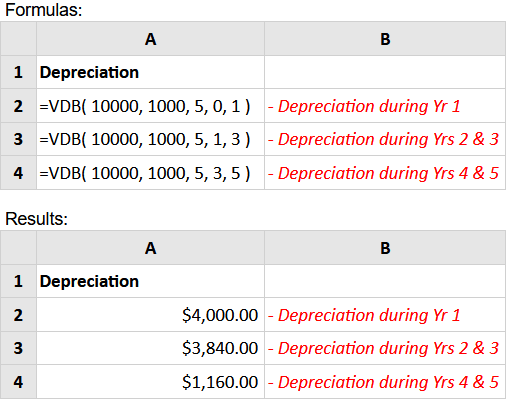EXCEL VDB FUNCTION
Excel VDB Function Introduction
The Excel VDB function computes a stock’s depreciation over time using the Double Declining Balance Method or another given depreciation rate (including partial periods).
Description of Excel VDB Function
Syntax :
=VDB( cost, salvage, life, start_period, end_period, [factor], [no_switch] )
Parameters :
cost – The asset’s initial purchase price.
Salvage – The asset’s worth at the conclusion of depreciation.
life -The number of periods over which an asset will be depreciated.
start period – The starting period for which the depreciation should be calculated.
end period – The period at the end of which you wish to compute depreciation.
- [factor] – An optional parameter for specifying the rate of depreciation.
If the function’s [factor] argument is missing, the default value of 2 (specifying the double declining depreciation technique) is used. - [no switch] – When depreciation exceeds the decreasing balance calculation, an optional logical argument determines whether the technique should switch to straight line depreciation. Possible values include:
– TRUE – Do NOT use the straight-line depreciation technique when depreciation exceeds the falling balance calculation;
– FALSE – DO use the straight-line depreciation method when depreciation exceeds the decreasing balance calculation.
If the [no switch] option is missing, the default value is FALSE.
Step By Step Guide of VDB Function
Example :
The VDB function in the spreadsheet on the right utilises the double declining depreciation technique to compute the depreciation over different time periods of an asset that costs $10,000 at the start of year 1 and has a salvage value of $1,000 after 5 years.
Because the total of the depreciations from years 1, 2, and 3 adds up to $9,000, the asset value at the end of year 5 is $10,000 – $9,000 = $1,000.
which, as predicted, is the given salvage value.
Also, because the [factor] and [no switch] parameters are missing in the examples, their default values are 2 and FALSE, respectively.

Key Points
#NUM! –
If any of the following conditions is encountered:
The specified cost, salvage, start period, end period, or [factor] parameters are all 0; the supplied life argument is also 0;
The specified start period is greater than the supplied end period; start period > life or end period > life#VALUE! – This error occurs if any of the supplied parameters is not a number.



